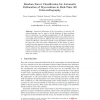Free Online Productivity Tools
i2Speak
i2Symbol
i2OCR
iTex2Img
iWeb2Print
iWeb2Shot
i2Type
iPdf2Split
iPdf2Merge
i2Bopomofo
i2Arabic
i2Style
i2Image
i2PDF
iLatex2Rtf
Sci2ools
FIMH
2009
Springer
2009
Springer
Random Forest Classification for Automatic Delineation of Myocardium in Real-Time 3D Echocardiography
Automatic delineation of the myocardium in real-time 3D echocardiography may be used to aid the diagnosis of heart problems such as ischaemia, by enabling quantification of wall thickening and wall motion abnormalities. Distinguishing between myocardial and nonmyocardial tissue is, however, difficult due to low signal-to-noise ratio as well as the efficiency constraints imposed on any algorithmic solution by the large size of the data under consideration. In this paper, we take a machine learning approach treating this problem as a two-class 3D patch classification task. We demonstrate that solving such task using random forests, which are the discriminative classifiers developed recently in the machine learning community, allows to obtain accurate delineations in a matter of seconds (on a CPU) or even in real-time (on a GPU) for the entire 3D volume.
Entire 3D Volume | FIMH 2009 | Medical Imaging | Real-time 3D Echocardiography | Two-class 3D Patch |
| Added | 17 Feb 2011 |
| Updated | 17 Feb 2011 |
| Type | Journal |
| Year | 2009 |
| Where | FIMH |
| Authors | Victor S. Lempitsky, Michael Verhoek, J. Alison Noble, Andrew Blake |
Comments (0)

